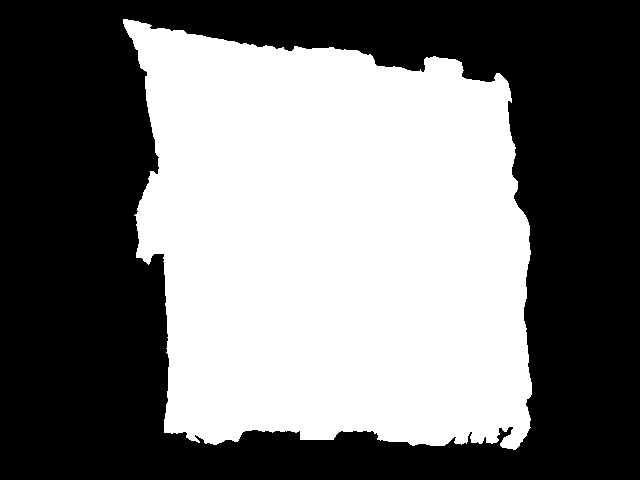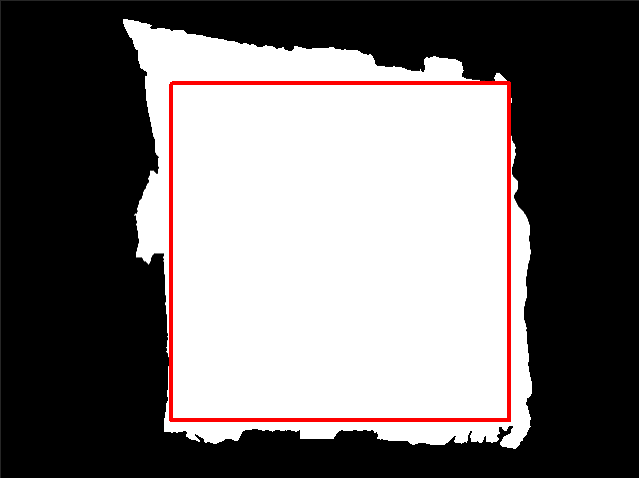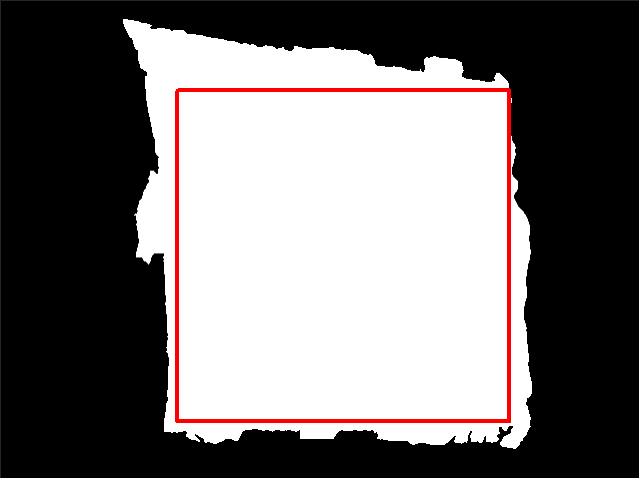CompenNet-plusplus
 CompenNet-plusplus copied to clipboard
CompenNet-plusplus copied to clipboard
Finding the optimal displayable area
Welcome to discuss more efficient algorithms.
For a mask image imMask below
 ,
the optimal displayable area (i.e., the largest inscribed rectangle) can be found by
,
the optimal displayable area (i.e., the largest inscribed rectangle) can be found by rect = getLargestRect(imMask, aspectRatio); where aspectRatio is the aspect ratio of the inscribed rectangle, and it should match your projector input images/frames aspect ratio.
-
When aspect ratio = 1,
rect = getLargestRect(imMask, 1);
-
When aspect ratio = 4/3,
rect = getLargestRect(imMask, 4/3);
Function getLargestRect is an iterative rectangle growing algorithm written in MATLAB 2021a, and is defined below:
%% find the largest inscribed rectangle of a binary image imBW.
function [rect] = getLargestRect(imBW, aspectRatio)
% aspectRatio is the aspect ratio of the inscribed rect (w/h)
h = size(imBW, 1);
w = size(imBW, 2);
% find candidate rect centers using distance transform
imDist = bwdist(~imBW);
[cy, cx] = find(imDist > prctile(imDist(imBW), 90)); % to speedup, only select the inner 90% points as candidate rect centers
% only use a subset for speedup (fix RNG seed to be deterministic)
seed = RandStream('mlfg6331_64');
idx = randsample(seed, length(cx), min(200, length(cx)));
cx = cx(idx);
cy = cy(idx);
% max size of the inscribed rect
maxH = 0;
% maxW = 0;
% for each candidate center
for i = 1: length(cy)
% left, right x and top and bottom y
lx = cx(i);
rx = cx(i);
ty = cy(i);
by = cy(i);
% iteratively grow the current inscribed renctangle toward top-left and bottom-right by 1 pix
while(1)
% move the top-left corner toward top-left by 1 pix
curH = by - ty + 1;
dx = round(curH * aspectRatio) - round((curH - 1) * aspectRatio);
if(ty - 1 >= 1 && lx - dx >= 1)
imRect = imBW(ty-1:by, lx-dx:rx);
if(nnz(~imRect(:)) == 0)
ty = ty - 1;
lx = lx - dx;
else
break;
end
else
break;
end
% move the bottom-right corner toward bottom-right by 1 pix
curH = by - ty + 1;
dx = round(curH * aspectRatio) - round((curH - 1) * aspectRatio);
if(by + 1 <= h && rx + dx <= w)
imRect = imBW(ty:by+1, lx:rx+dx);
if(nnz(~imRect(:)) == 0)
by = by + 1;
rx = rx + dx;
else
break;
end
else
break;
end
end
% record the centers with the largest inscribed rectangle
curH = by - ty + 1;
if(curH > maxH)
maxH = curH;
bestx = cx(i);
besty = cy(i);
bestRect = [lx, ty, rx-lx+1, by-ty+1];
elseif(curH == maxH)
bestx = [bestx, cx(i)];
besty = [besty, cy(i)];
bestRect = [bestRect; [lx, ty, rx-lx+1, by-ty+1]];
end
end
% finally, find the best rect whose center has the largest distance
[~, idx] = max(imDist(sub2ind(size(imDist), besty, bestx)));
rect = bestRect(idx, :);
figure; imshow(imBW); rectangle('Position', rect, 'EdgeColor','r', 'LineWidth', 3); drawnow
end
When I used the code as it was, there was an issue that I could not get the same result as the image above the this page. However, in my case, the same result could be obtained by changing line 9 [cy, cx] = find(imDist > prctile(imDist(imBW), 90)); to [cy, cx] = find(imDist > prctile(imDist, 90));
Matlab 2021b version was used, and ad-on installed only Statistics and Machine Learning Toolbox, Image Processing Toolbox, and Computer Vision Toolbox.
Thank you for the feedback. Maybe it's due to the MATLAB version. Note that this modification may not work well in other versions, and it produces a suboptimal result in MATLAB 2021a.
